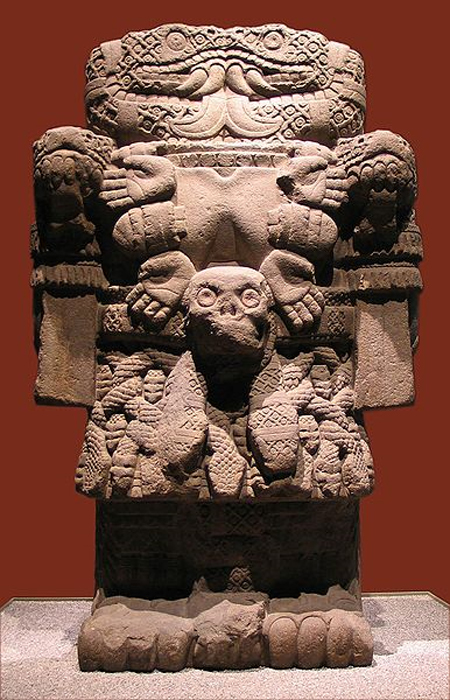
Huitzilopochtli: The Hummingbird War God at the Forefront of the Aztec Pantheon
Huitzilopochtli was one of the most important deities in the Aztec pantheon. They saw him as the god of the sun, warfare, military conquest, sacrifice, and the patron god of Tenochtitlan. Additionally, Huitzilopochtli was regarded as the supreme god by the Mexicas, who became the rulers of the Aztec Empire. The Mexicas believed that it was Huitzilopochtli who brought them from their mythical homeland of Aztlan to Central Mexico.
What’s in a Name?
The name Huitzilopochtli is composed of two Nahuatl words, huitzilin, and opochtli, which mean ‘hummingbird’ and ‘left’ respectively. Thus, the name of this god literally meant ‘Hummingbird of the Left (or South, as the Aztecs believed that the south was the left side of the world)’. Thus, it is of little wonder that Huitzilopochtli is artistically depicted as a hummingbird, though occasionally, he is also portrayed as an eagle. The hummingbird was an important creature to the Aztecs, as they believed that they were the reincarnation of dead warriors.

Depiction of Huitzilopochtli in the Codex Telleriano-Remensis ( Public Domain)
Huitzilopochtli’s Violent Birth
According to one well-known Aztec myth, Huitzilopochtli was the son of Coatlicue (meaning ‘She of the Serpent Skirt’), a primordial earth goddess. In this myth, Coatlicue was sweeping the floor of a temple on Coatepec (meaning ‘Snake Hill’), when a ball of hummingbird feathers fell from the sky. Coatlicue picked the ball of feathers up, and kept it in her bosom, resulting in her becoming pregnant with Huitzilopochtli.
When her sons, the Centzon Huitznahua, (meaning ‘400 Southerners’), who were the gods of the stars, and daughter, Coyolxauhqui, a moon goddess, heard of their mother’s pregnancy, they were furious, and sought to kill her. Coatlicue was saddened by this, but the unborn Huitzilopochtli told her not to be afraid. Eventually, Coatlicue’s children came to Coatepec to kill her.

Coatlicue statue displayed in National Anthropology Museum in Mexico City. (Luidger/CC BY SA 3.0)
Before they could lay their hands on her, however, Huitzilopochtli emerged fully grown from his mother’s womb. With his weapon, the xiuhcoatl (meaning ‘turquoise snake’), Huitzilopochtli decapitated his sister and killed most of his brothers. As Huitzilopochtli was regarded as a solar deity, this story may be interpreted as the triumph of the sun over the night, the moon, and the stars.
Sacrifice!
Although Huitzilopochtli succeeded in vanquishing his siblings, the Aztecs believed that the struggle continued anew each day, and that the sun’s victory was not certain. Therefore, to aid Huitzilopochtli in his battle against night, and therefore ensuring that the world continued to exist, the Aztecs needed to provide nourishment to the god.
- Sacrificial Young Wolf Adorned with Best Quality Aztec Gold Ever Found is Discovered in Mexico City
- Tezcatlipoca: How Does the Supreme God of the Aztecs Compare to Other Omnipotent Deities?
- Art of an Empire: The Imagination, Creativity and Craftsmanship of the Aztecs
This took on the form of blood from a human heart, which was the reason why the Aztecs had to perform human sacrifices each day. The sacrificial victims, normally war captives, would be taken up the Templo Mayor, the main temple in Tenochtitlan. On top of the temple, priests would cut out the heart from the chest of the sacrificial victims. The dead bodies would then be thrown down the steps of the temple onto a stone carved with the image of Coyolxauhqui, thus symbolising the killing of the moon goddess by Huitzilopochtli.

Aztec ritual human sacrifice portrayed on page 141 (folio 70r) of the Codex Magliabechiano. (Public Domain)
Leading the Mexica to New Lands
Another important myth about Huitzilopochtli depicts him as the one who brought the Mexica from their homeland to Central Mexico. The Mexica believed that they were originally from a place called Aztlan (meaning ‘place of the heron’), which is believed to be located somewhere in the north.
They believed it was Huitzilopochtli who guided the Mexica during this migration. The god’s priests were told to settle in the place where they saw an eagle perched on a cactus growing out of a rock, or, according to another version, an eagle devouring a snake on a rock. In any case, the priests saw this sign on an island in the middle of Lake Texcoco and established the city of Tenochtitlan there.

Model of the Aztec City of Tenochtitlan at the National Museum of Anthropology in Mexico City. (Public Domain)
Top Image: Depiction of Huitzilopochtli in the Tovar Codex. Source: Public Domain
By Wu Mingren
References
Bitto, R., 2017. War God of the Aztecs: Huitzilopochtli. [Online]
Available at: http://mexicounexplained.com/war-god-aztecs-huitzilopochtli/
Maestri, N., 2017. Huitzilopochtli - Aztec God of the Sun, War and Sacrifice. [Online]
Available at: https://www.thoughtco.com/huitzilopochtli-aztec-god-of-the-sun-171229
The Editors of Encyclopaedia Britannica, 2016. Huitzilopochtli. [Online]
Available at: https://www.britannica.com/topic/Huitzilopochtli
Webley, K., 2011. Huitzilopochtli, Aztec God of Sun and War. [Online]
Available at: http://content.time.com/time/specials/packages/article/0,28804,2046823_2046865_2046845,00.html
www.mexicolore.co.uk, 2018. God of the Month: Huitzilopochtli. [Online]
Available at: http://www.mexicolore.co.uk/aztecs/gods/god-of-the-month-huitzilopochtli
www.mythencyclopedia.com, 2018. Huitzilopochtli. [Online]
Available at: http://www.mythencyclopedia.com/Ho-Iv/Huitzilopochtli.html
















Comments
King name "Huitzilopochtli" The Divine leader who rescued an ancestral people from his devastated island kingdom in the Atlantic Ocean, Aztlan. Arriving in the Valley of Mexico, they built a new capital to commemorate their lost city, when Tenochtitlan was constructed on a rocky island at the center of a man-made lake.
godfinder.org